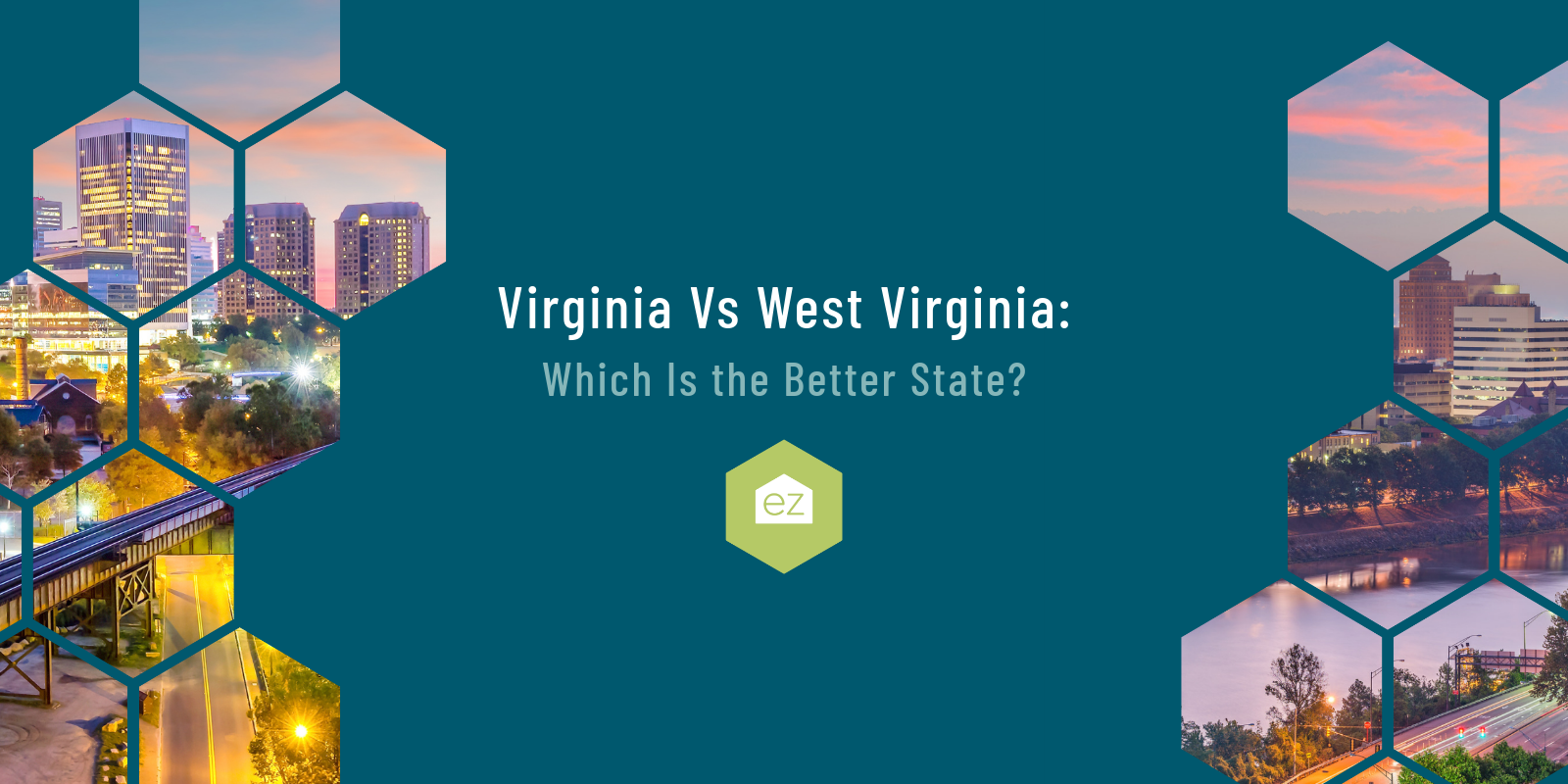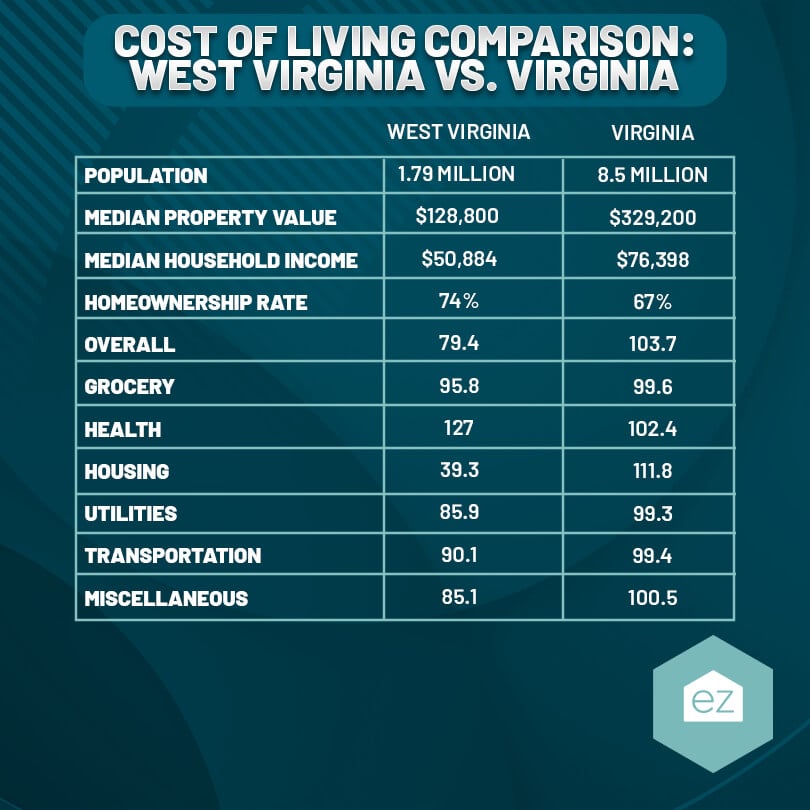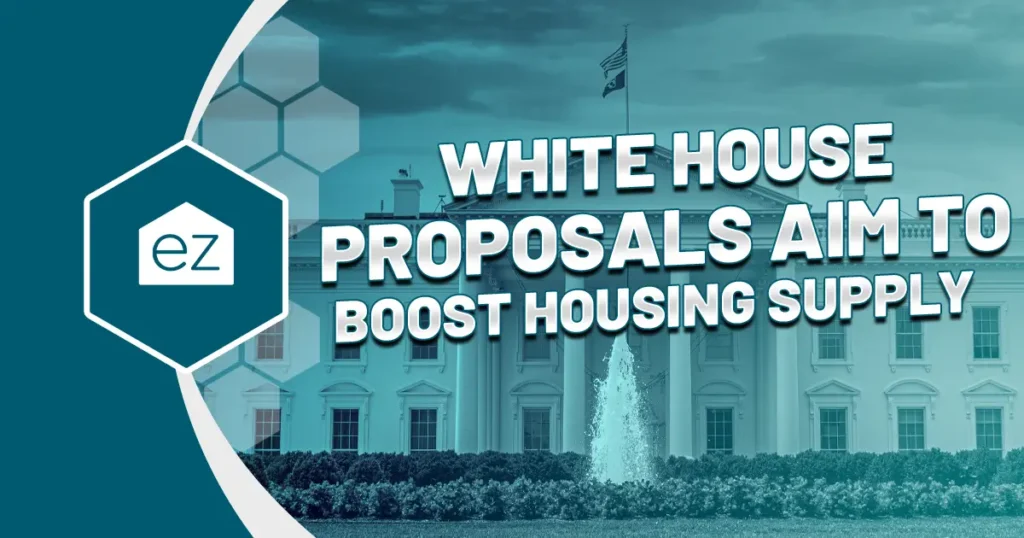Virginia Vs West Virginia: Which Is the Better State?

Virginia Vs West Virginia: Which Is the Better State?
Are you debating whether to make a move to Virginia or West Virginia? These neighboring states are experiencing more growth and interest, even if they aren’t in the national hotspots of the South. And, with both states providing unique lifestyles and beautiful scenery, it can be tough to decide which is right for you!
We’ll compare and contrast these two beautiful states, exploring their amenities, cultural offerings, and economies. While Virginia and West Virginia have their advantages, each has divergent aspects that may make one the better state for you.
Cost of Living

The Sperling Best Places Index helps compare the cost of living for two places using a system where the national average is set at 100. Any score below 100 indicates that the expense category is overall cheaper than average, while a score above 100 means it is more expensive.
You might expect West Virginia to be the cheaper of the two states, and you would be right. When it comes to how much you spend to live, the Mountain State is the clear winner. Residents spend about 20% less than the national average on their overall cost of living. Every single category the index looks at is under 100.
Virginia’s overall score is much higher at 103.7. The only category where Virginia fares better for expenses is healthcare, which does have to do with West Virginia’s challenges in providing access to healthcare for its citizens.
But you also have to consider that West Virginia has significantly fewer people living there. Virginia’s demand for goods and services is simply higher because there’s more competition.
Here’s the full breakdown:

*These figures are based on the US 2020 Census.
Remember, the cost of living varies widely across a state. For example, the cost of living in Arlington, VA, is much higher than in Richmond, VA.
Population Growth

Looking into a state’s population can provide insight when deciding where to live. A growing state is excellent for those wanting more economic opportunities and access to many amenities. But, if you’re after a more affordable lifestyle or desire rural living, finding somewhere with slower growth might make sense.
Virginia ranked as the 15th fastest-growing state by population. Between 2010 and 2020, the state added over 650,000 new residents, bringing the 2020 Census count to 8,654,542. The state projects its population will increase by 6% to 9.1 million by 2030. Still, this is slowing population growth compared to prior decades.
Fairfax and Prince William are the most populated counties in Virginia, with Loudoun County not far behind as the state’s fastest-growing area.
While Virginia’s growth is slowing down, West Virginia is in decline based on the Census figures. It lost around 60,000 residents between 2010 and 2020. About another one percent left from 2020 to 2022. Projections have the state losing around one percent of its population from 2010 to 2030. Part of us is due to a rapidly aging population combined with the loss of people in their prime working years seeking other job market opportunities.
Some areas of the state are expected to grow. Monongalia, Jefferson, and Berkeley are the top three counties to add to its population. All of these are around West Virginia’s largest cities.
Outdoor Recreation

The enchanting outdoors is a reason why people come to Virginia. Home to 41 state parks, 63 natural areas, and 670 miles of scenic paths, Virginia’s outdoors are perfect for hiking, biking, or simply exploring nature’s splendor!
Virginia recreational activities range from trails through the Blue Ridge Mountains to beach fronts along the Atlantic Ocean and the Chesapeake Bay. The majestic views at Shenandoah National Park and the Appalachian Trail are among its most well-known, but you’ll find beautiful views across the state.
With 7,213 miles of shoreline, there are endless opportunities for water recreation, from saltwater fishing to whitewater kayaking. The John H. Kerr Reservoir is the state’s largest lake, with 800 miles of shoreline all by itself. Other popular lakes for living and recreation include Smith Mountain Lake, Lake Anna, Lake Gaston, and Claytor Lake.
At Virginia Beach, you can soak up the sun and have fun at its resorts and public parks. Or, if a more laid-back experience sounds appealing, head over to Sandbridge Beach or Cape Charles for some beach life serenity.
While outdoor recreation in Virginia is plentiful, West Virginia stacks up just as equally—just in a different way. This is the Mountain State, after all. It’s the only state completely inside the Appalachian mountains!
That Appalachian Trail that runs through Virginia also runs through part of West Virginia. It’s just one of the thousands of miles of hiking trails that locals have access to. Those same mountains have attracted people for their world-class fly fishing and whitewater rafting. The New River Gorge National Park is among the nation’s newest national parks, but it’s long been a destination with Class IV+ waters and rock climbing.
One thing West Virginia may do a little better than its neighbor is winter sports. The four ski resorts here are slightly larger and provide more access to downhill skiing, cross-country skiing, and snowshoeing.
The state is a destination for mountain biking, with popular trails in the Kanawha State Forest and the Monongahela National Forest. The Hatfield-McCoy mountains are renowned for their off-roading trails.
While West Virginia has no oceanfront beaches, it has a mountain lakes region. These deep fresh waters are the state’s destination for boating and cooling off in summer.
City Living

Virginia Beach, the most-populated city in Virginia and home to over 463,000 residents, is a beach enthusiast’s paradise. Virginia Beach is the mid-Atlantic seaboard destination for beachfront fun, boasting what Guinness World Records calls the longest “pleasure beach” on Earth. Shopping spots, restaurants, and bars line its iconic three-mile boardwalk. It hosts annual events like East Coast Surfing and American Sand Soccer Championships.
Thanks to a rich history from both the Revolutionary War and Civil War, Richmond invites visitors to explore its vibrant past with numerous museums and historic sites. But it’s very much a modern city, with eight Fortune 500 corporations headquarters, such as Carmax and Universal. This charming city cultivates a “hipster” vibe with blocks of indie shops, trending craft breweries, and live music venues. The attractions include a water theme park, the NASCAR races at Richmond Raceway, and quiet botanical gardens.
What these two areas miss, though, is they aren’t really the most populated part of the state. For that, look at Northern Virginia, part of the Washington, DC, metro. Because it is divided into many smaller, independent cities, they don’t register on Virginia’s most populated city lists. Taken together, they are the densest part of the state. Among these cities are top destinations like Arlington, Alexandria, Fairfax, and Manassas. Here, you’re near the iconic attractions of Washington, DC, like the Smithsonian Museums along the Mall or the US Congress. Each city has unique features, like parks along the Potomac River or a thriving dining scene.
In truth, Virginia has a wide selection of cities to explore before you move to the state.
West Virginia simply can’t stack up to Virginia’s cities in size or amenities. Charleston, the state’s largest city and capital, is more of a large town when you compare it to Virginia’s top place to live, Arlington, VA. Still, Charleston has its charms, like the meandering Kanawha River and the access to the outdoors. It’s also much easier to get around Charleston, thanks to its less dense population.
The state’s other large cities, based on population, are Huntington and Parkersburg, both on the border with Ohio.
Education

The clear winner for quality education is Virginia, ranked tenth for K-12 public education and 17 in higher education, for an overall 12th place ranking. The public education system is broken into 133 districts that serve 1.25 million students each year.
Virginia also has a handful of well-known colleges and universities, including the University of Virginia, Virginia Tech, and the College of William and Mary.
According to rankings from the US News and World Report, West Virginia’s K-12 schools have room to grow. Their evaluation placed the state an overall No. 45 on its annual list. PreK-12 was no. 41. The public school system is tied to the local counties, resulting in 55 districts and 683 schools.
For higher education, ranked 47th, the state has eight public universities or four-year colleges and 13 community/technical colleges. West Virginia University is ranked highest, followed by Marshall University and Shepherd University.
Climate
The two states share some similar climate conditions, although the different elevation between the two definitely impacts your experience. Both states experience four distinct seasons, and the weather gets more moderate the further east you go.
Those living in West Virginia’s higher mountain areas can expect cooler temperatures and more precipitation than those in lower elevations. The average summer high in the central mountains is around 80F, while it peaks at about 85F in southwest West Virginia. Winter average minimum temperatures range from 20F in the northeastern and central mountains to 30F in the far south.
Rainfall ranges from 35-50 inches each year, depending on where you live in the state. The eastern Panhandle sees the lowest amount of precipitation. Higher elevations and northern areas report more snowfall.
Virginia’s western area is similar to the West Virginia weather, and it’s where the state sees its most snowfall. Once you cross the Blue Ridge Mountains, winters can vary wildly. The state averages 10 inches of snow, but snow storms can happen anywhere, even closer to the coastline.
Virginia experiences a subtropical climate east of the mountain range with hot, humid summers averaging in the mid-80sFs. However, all of the state does experience winter cold, with averages reaching as low as 25F.
Thunderstorms and tornadoes are common in the state, with the most occurring during the spring and summer. Coastal areas may experience tropical storms and hurricanes when in season.
Real Estate Taxes
Both states base property taxes on your county and municipality, and their millage rates are $1 per every $100 of valuation. And, luckily enough, each has property taxes lower than the United States national average. The big differences will result from property values and millage rates.
West Virginia’s laws cap how much individual counties and municipalities can charge for a millage rate. Residential real estate is taxed on 60% of its assessed value, which is re-valued yearly. The state has one of the nation’s lowest average effective tax rates, ranking it tenth in the nation for low property taxes during 2023.
For Virginia, the property taxes aren’t terrible, but they’re not as good as West Virginia. All homes are charged at 100% of their determined value.
Counties (or independent cities, like Richmond) set the market value, which re-value properties between two to six years. The average effective tax rate in 2023 was 0.82%, or 20th in the nation.
Disabled and elderly residents (65 or older) may qualify for property tax exemptions in Virginia, with the amount of the exemption dependent on their income.
Taxes for Retirees
It may surprise you that West Virginia has a favorable retirement environment. Some independent media sites rank it as high as the third best place to retire, while Bankrate has it as its 11th choice. Much of its high ranking boils down to its incredible housing affordability.
West Virginia does have an individual income tax, which ranges between 3%-6.5% depending on how much you make. However, Social Security benefits are excluded from taxable income for single taxpayers with a federal adjusted gross income under $50,000. For joint filers, the income must be less than $100,000 for this exemption.
The state also provides some tax breaks for federal, state, and local government retirement plans if you are a first responder or have a military pension or railroad retirement benefits. Some other West Virginia-designated retirement plans are exempt for up to $2,000.
Taxpayers 65 and older can deduct up to $8,000 in other income that is not otherwise exempt. These taxpayers are also entitled to a $20,000 assessed value exemption on their owner-occupied residence. It could be possible to still lower your property taxes thanks to other special tax credits and exemptions based on the county and your annual income.
Virginia is slightly less tax-friendly for retirees, but its overall burden isn’t too bad. Income is taxed at the state rate of 2-5%. Pension incomes and retirement account withdrawals are only partially taxed. Like its next-door neighbor, there are no taxes on Social Security income or railroad retirement benefits.
Virginia also offers an age deduction on taxes. Residents 65 and older can deduct $12,000 from their taxable income. Veteran residents 55 and older can deduct up to $10,000 of their military retirement income and other benefits as of 2022, increasing to $40,000 by 2025.
Job Markets
In terms of choices and diversity, Virginia wins out. However, many job market opportunities are concentrated in the northern Virginia markets or closer to the Virginia Beach region. That’s not to say that there aren’t thriving industries in other parts of the state, like around Charlottesville or Richmond. It just means there is more selection in different industries in these areas.
The state’s top industries include leisure and hospitality, professional and business services, information technology, distribution and logistics, and manufacturing. The top employers in the state based on size are the government and the US Armed Forces. For Fortune 500 companies, Virginia had 21, including Freddie Mac, General Dynamics, and Northrop Grumman. Its largest companies were spread across industries, from retailers like Dollar Tree to healthcare logistics like Owens & Minor.
The economy in neighboring West Virginia is often associated with coal and energy. While these remain essential parts of the state’s economy, tourism is now the state’s leading industry. West Virginia has been working hard to diversify its job market and attract new opportunities into the state.
Based on the number of persons employed, West Virginia’s leading industries are government, healthcare, mining, and manufacturing. Some of its largest individual employers are in the healthcare industry or service providers like Kroger or Lowe’s. It doesn’t have any Fortune 500 headquarters in the state. Still, these companies run manufacturing arms, like the Toyota Motor and General Motors facilities.
Sports
Interestingly, both states actually lack a professional sports team. Virginia is a home base for two teams, one in the NFL and one in the NHL, but these teams represent Washington, DC.
To make up for the lack of professional sports, both states have minor league teams playing in hockey, baseball, and soccer. Virginia also has a minor league basketball team.
Culture in West Virginia and Virginia
In both states, you’ll find that many residents live up to the South’s reputation for charm and hospitality.
With a unique mix of Northern and Southern cultures, Virginia is the perfect combination of both worlds! Whether visiting for business or pleasure, be prepared for some warm hospitality from this state’s residents! From its stunning colonial architecture to its world-renowned literature, art, and music performances – you’ll never run out of fascinating things to explore. And don’t forget about their deliciously distinct cuisine, like Old Bay Seafood dishes or smoky BBQ with the signature vinegar-based sauce.
West Virginia epitomizes Appalachian folk culture with a strong musical and artistic tradition. The settlers brought Celtic and African influences to create something all their own. Today, you can see and hear this in the state’s many folk music festivals and the local art galleries. For dining, you can’t miss out on the pepperoni rolls or stopping at Tudor’s Biscuit World.
Choosing Between West Virginia and Virginia
Whether to live in Virginia or West Virginia comes down to personal preference! Both have perks, from bustling urban centers, beaches, and mountains for outdoor exploration, to delicious local cuisines and special cultural attractions. If you’d prefer a quieter lifestyle, maybe the mountains of West Virginia are calling your name. But Virginia’s the better choice if city living has your desired amenities.
To be sure you’ll find the perfect place to call home in either state, we recommend connecting with a real estate agent who will make your research process easier.
Start Your Home Search
Preston Guyton
Share this Post
Related Articles
Real Estate News
White House Proposals Aim to Boost Housing Supply
Real Estate News
NAR Settlement Set to Reshape The Business of Real Estate
Real Estate News
2023 Reports Increased Demand for New Construction Homes
Real Estate News





